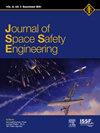飞行器安全和空间飞行器的危害:未来的飞行对空间碎片的危害有多安全?
IF 1.7
Q3 ENGINEERING, AEROSPACE
引用次数: 0
摘要
航空安全和空间操作之间的关系已经成为公众眼中一个有争议的话题,也是空间安全专业人员的一个严肃问题。媒体的报道引起了公众对一些事件的关注,其中包括欧洲领空的关闭,原因是中国的上层火箭重新进入大气层,后来坠入了印度洋。美国联邦航空局最近向国会提交的一份报告显示,根据航空航天公司(Aerospace Corporation)的一项分析,“2035年发生飞机坠毁事故的概率为每年0.0007起”,该分析考虑了全球飞机交通量和在轨物体数量的预计增长。SpaceX公司公开表示反对,因为他们的分析表明,“星链”卫星在重返大气层时完全烧毁。然而,最近事件的证据证明,用于预测星链、龙躯干和国际空间站电池托盘死亡的分析往往低估了2.2节中解释的重返大气层后幸存的碎片。美国联邦航空局对哥伦比亚号事故的研究使用了实际商用飞机轨迹的数据,发现任何一架飞机受到撞击的最高条件概率(考虑到解体事件发生的时间和地点)在1000分之一到100分之一之间,这取决于有多少碎片幸存到飞机高度,但未被回收。本文通过解释目前为保护飞机在发射和再入期间免受空间碎片的潜在影响所做的工作来避免争议。本文将以最简单的术语描述美国联邦航空局在发射和再入期间采用的飞机保护措施的支柱,并回答几个关键问题:美国联邦航空局如何确定对可能受到太空飞行器碎片碰撞威胁的飞机的安全程度?美国联邦航空局如何建立关闭或通知的空域区域,以确保美国发射、再入和处置操作期间的安全?采取了哪些措施来提醒飞机注意计划外或不受控制的空间碎片(包括流星体等自然碎片)的碎片危害?考虑到大型LEO星座生命周期的潜在威胁,包括部署它们所需的所有发射,目前的最佳实践是否足以维持当今高水平的飞机安全,或者我们是否应该共同努力开发更先进的方法?本文章由计算机程序翻译,如有差异,请以英文原文为准。
Aircraft safety and space vehicle hazards: How safe from space debris hazards will your future flights be?
The nexus between aviation safety and space operations has emerged as a controversial topic in the public's eye and a serious matter for space safety professionals. Media reports have drawn the public's attention to events including the closing of European airspace because of the re-entry of a Chinese upper-stage that later impacted the Indian Ocean. A recent FAA report to Congress indicated that "the probability of an aircraft downing accident in 2035 would be 0.0007 per year," based on an analysis by the Aerospace Corporation that accounted for the projected growth in global aircraft traffic and the number of on-orbit objects. SpaceX publicly objected because their analysis indicates that Starlink satellites completely burn up on re-entry. However, evidence from recent events proves that the analyzes used to predict the demise of Starlink, the Dragon trunk, and an ISS battery pallet are prone to underestimate the debris that survives re-entry as explained in Section 2.2. A FAA study of the Columbia accident used data on the actual commercial aircraft trajectories and found that the highest conditional probability of impact to any individual aircraft (given the break-up event occurred when and where it occurred) was between 1 in 1000 and 1 in 100, depending on how many fragments survived to aircraft altitudes but were unrecovered. This paper avoids the controversies by explaining what is currently done to protect aircraft from potential impacts by space debris during launch and re-entry. This paper will describe, in the simplest terms possible, the pillars of aircraft protection measures employed by the FAA during launch and re-entry, and answer several key questions:
How does the FAA establish how safe is safe enough for aircraft that are potentially threatened by a collision with space vehicle debris?
How does the FAA establish the regions of airspace that are closed or notified to ensure safety during US launch, re-entry, and disposal operations?
What is done to alert aircraft to debris hazards from unplanned or uncontrolled space debris (including natural debris such as meteoroids)?
Are the current best practices enough to sustain today's high level of aircraft safety given the potential threats from the lifecycle of large LEO constellations, including all the launches needed to deploy them, or should we be working together to develop more advanced methods?
求助全文
通过发布文献求助,成功后即可免费获取论文全文。
去求助
来源期刊

Journal of Space Safety Engineering
Engineering-Safety, Risk, Reliability and Quality
CiteScore
2.50
自引率
0.00%
发文量
80
 求助内容:
求助内容: 应助结果提醒方式:
应助结果提醒方式:


